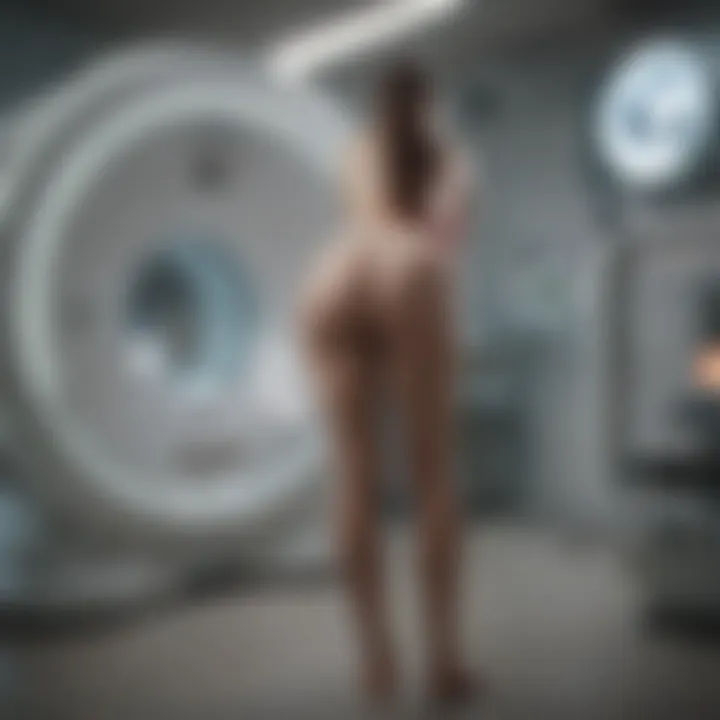MRI Scan for Hip: A Comprehensive Overview


Intro
In the realm of diagnostic imaging, MRI scans stand out for their ability to visualize intricate structures with remarkable clarity. This article focuses on the specifics of MRI scans pertaining to the hip region, a critical area for evaluating musculoskeletal disorders and injuries. As conditions related to the hip can significantly affect mobility and quality of life, understanding the role of MRI in this context is crucial for both practitioners and patients.
The hip joint, a ball-and-socket structure, plays a vital role in human locomotion. MRI, as a non-invasive imaging technique, provides an excellent view of the soft tissues, cartilage, and surrounding structures, which are often not visible through traditional X-rays. This overview will dissect the significance of MRI in diagnosing various conditions, describe the procedural nuances, and emphasize the importance of patient cooperation during the process.
Considering the complexity of hip anatomy, familiarity with the typical appearances of different pathologies on MRI is beneficial for accurate diagnosis. Furthermore, this article will address potential limitations of MRI, offering a balanced perspective that encompasses both the potentials and challenges present in this field.
Let’s explore the key concepts established in the following sections to enhance understanding of the MRI process, its implications, and its future directions in hip diagnostics.
Preamble to MRI Scans
MRI, or Magnetic Resonance Imaging, stands as a leading technology in the medical imaging landscape. Understanding the foundation of MRI is vital for comprehending its impact, especially in the context of the hip region. The hip joint is a complex structure, and any disorders or injuries can significantly affect a person's mobility and quality of life. Thus, a deep dive into MRI scans provides valuable insights for students, researchers, educators, and healthcare professionals alike.
By employing MRI, clinicians can access detailed images of the hip's anatomy, enabling accurate diagnoses of potential issues. From arthritis to tears in the cartilage or tendons, an MRI helps identify abnormalities that may not be visible using traditional X-rays or CT scans.
Moreover, understanding MRI imaging enhances patient care. It allows healthcare providers to explain procedures and results clearly, fostering trust and knowledge in patients. The technology is non-invasive, making it a preferred choice for assessing hip conditions without the need for exploratory surgery.
In this section, two critical aspects of MRI will be explored: 1) the definition of MRI, which will clarify its operational principles and significance, and 2) the history of MRI technology, providing context on its evolution into the indispensable diagnostic tool it is today.
Definition of MRI
Magnetic Resonance Imaging utilizes powerful magnets and radio waves to create detailed images of organs and tissues within the body. Unlike X-rays, MRI does not rely on ionizing radiation. Instead, it generates images based on the magnetic properties of hydrogen atoms within the body, which are plentiful in water and fat.
During an MRI scan, the patient lies inside a large magnet. The magnet creates a magnetic field that causes the hydrogen atoms to align. Radio frequency pulses are then emitted, disrupting this alignment. When these pulses are turned off, the hydrogen atoms return to their original positions, releasing energy in the process. This energy is detected and processed by a computer to produce detailed images.
MRI has gained popularity due to its remarkable ability to visualize soft tissues, providing clarity that is essential for diagnosing various ailments. It is particularly effective for examining the hip joint, which consists of bones, cartilage, ligaments, and surrounding muscles.
History of MRI Technology
The journey of MRI technology began in the late 20th century, with early concepts rooted in nuclear magnetic resonance (NMR). The first experimental images were produced in the 1970s. In 1973, Dr. Raymond Damadian performed the first full-body scan. His pioneering work laid the groundwork for future advancements in MRI technology.
Following Damadian, further developments, including the invention of gradient coils, motivated researchers to refine and enhance image quality. By the late 1980s, MRI machines became commercially available, marking a significant milestone in diagnostic imaging.
As technology progressed, improvements in computing power and software greatly enhanced MRI's capabilities, allowing for faster scans and superior image clarity. Today, MRI stands as a cornerstone in clinical diagnostics, particularly for assessing complex conditions of the hip.
"MRI technology has transformed the landscape of medical imaging, providing critical insights into soft tissue conditions that were previously challenging to diagnose."
Understanding the Hip Anatomy
Understanding the anatomy of the hip is essential for several reasons. It aids in accurate diagnosis of hip-related conditions and ensures that MRI scans are interpreted effectively. With a well-defined hip structure, healthcare professionals can identify abnormalities or diseases much more efficiently. An in-depth comprehension of hip anatomy also enhances patient communication, allowing professionals to explain findings and procedures clearly.
The hip joint is a complex structure that plays a significant role in mobility and weight-bearing activities. Analyzing this joint through MRI helps in diagnosing conditions such as arthritis, fractures, and soft tissue injuries. By emphasizing its anatomical components, we can appreciate the interplay between bones, cartilage, muscles, and ligaments.
Components of the Hip Joint
The hip joint is primarily a ball-and-socket joint, formed by two main components: the acetabulum and the femoral head. The acetabulum is a deep socket located in the pelvis that houses the top of the femur. This anatomical design promotes stability and allows a wide range of motion.
Key elements of the hip joint include:
- Femoral Head: The spherical upper end of the femur that fits into the acetabulum.
- Acetabulum: The cup-shaped socket in the pelvis that forms the hip joint.
- Cartilage: A smooth tissue covering the femoral head and the acetabulum that reduces friction and absorbs shock.
- Ligaments: Tough bands of tissue that connect bones to one another, providing stability to the joint.
Each of these components works in sync to facilitate smooth movements while supporting the weight of the body during daily activities. Understanding these parts is crucial when assessing injuries or degenerative diseases through MRI imaging.
Surrounding Soft Tissues
Soft tissues surrounding the hip joint play a critical role in its overall function. These include muscles, tendons, and bursae that contribute to hip stability, flexibility, and strength.


Key components of surrounding soft tissues include:
- Muscles: Several major muscle groups, including the gluteals and iliopsoas, are vital for hip movement and stabilization.
- Tendons: Tendons connect muscles to bones. They transmit forces that allow for movement and also provide joint stability.
- Bursae: These are fluid-filled sacs that cushion the joint, reducing friction between bones and soft tissues during movement.
Examinations via MRI can reveal issues in these soft tissues and help diagnose conditions like tendinitis, bursitis, or tears in the muscles. Comprehensive knowledge of these aspects allows healthcare providers to make informed decisions regarding treatment and intervention.
Indications for Hip MRI
MRI scans for the hip are pivotal in diagnosing various conditions that affect both the joint and its surrounding structures. Understanding the indications for hip MRI is essential for healthcare providers in making informed decisions regarding a patient’s care. This section outlines the principal reasons why an MRI might be recommended, presenting a clear perspective on the benefits and considerations involved in the process.
Joint Disorders
Joint disorders, including conditions like osteoarthritis and rheumatoid arthritis, are frequent causes of hip pain and dysfunction. MRI is particularly beneficial in assessing the extent of cartilage damage, bone edema, and the presence of joint effusions. The images produced by MRI offer a detailed view of the structures within the joint, allowing for precise identification of abnormalities. This level of detail is not always possible with other imaging modalities, making MRI a preferred choice.
In addition to common degenerative joint diseases, MRI can help detect inflammatory conditions that may not be visible through X-rays. It is crucial for clinicians to understand these indications as timely and accurate diagnosis can significantly influence treatment plans and improve patient outcomes.
Trauma and Injury Assessment
In cases of trauma, an MRI can be invaluable for evaluating soft tissue injuries and bone fractures within the hip region. Traditional imaging techniques such as X-rays may miss subtle injuries to ligaments and muscles. An MRI provides a more comprehensive view, making it easier to identify tears, strains, and other injuries.
This imaging method is particularly useful for athletes or individuals involved in high-impact activities, where quick and precise assessment is critical. MRI examinations can reveal not only fractured bones but also related soft tissue injuries, facilitating effective management and rehabilitation strategies.
Tumor Detection
Another essential indication for hip MRI is tumor detection. This imaging technique plays a significant role in assessing bone tumors, metastases, or other pathologies that could present in the hip area. The ability to discern between benign and malignant lesions is crucial for determining the necessary treatment steps.
MRI is preferred due to its exceptional soft tissue contrast, which allows for a clear differentiation between tumor tissue and surrounding healthy tissues. Timely detection of tumors can lead to better prognoses and more effective treatment options. For clinicians, recognizing the signs that may warrant an MRI for tumor evaluation is an important aspect of patient care.
MRI Scan Procedure for the Hip
Understanding the MRI scan procedure is essential for both healthcare providers and patients. This process provides a glimpse into the intricate workings of the hip joint and surrounding soft tissues. Knowing the steps involved helps prepare patients mentally and physically for the scan. Furthermore, it enhances the quality of the images obtained, directly impacting the effectiveness of diagnoses made by medical professionals.
Preparation for the Scan
Preparation plays a crucial role in ensuring an optimal MRI experience. Patients may need to follow specific protocols before undergoing the scan.
- Clothing and Accessories: Patients should wear loose-fitting clothing, avoiding metal fasteners or accessories. Jewelry, watches, and hairpins must be removed, as they can interfere with the magnetic field.
- Medical History: Providing a complete medical history is essential. Patients should inform their doctor about existing conditions, allergies, or any electronic implants, such as pacemakers, because these can limit MRI suitability.
- Dietary Restrictions: In most cases, no special diet is needed. However, for specific circumstances, particularly if contrast material is required, medical professionals might recommend fasting before the test.
- Relaxation Techniques: Anxiety can hinder the scanning process. Practicing relaxation methods, like deep breathing exercises, can help users stay calm during the scan.
The Scanning Process
The scanning process itself is where the actual imaging takes place. The procedure usually lasts about 30 to 90 minutes, depending on the complexity of the case and the specific MRI machine used.
- Positioning: Patients will lie on a padded table. The hip region will be aligned with the opening of the magnet.
- Coils and Contrast Agents: Depending on the situation, a specialized coil may be positioned around the hip for better imaging. In some instances, a contrast agent is injected to enhance the clarity of the images.
- Scanning: The MRI machine generates radio waves and a strong magnetic field. During the scanning, it is crucial for the patient to remain still to avoid blurring the images. This is also the time when instructions will be given, often asking patients to hold their breath at intervals.
- Support and Communication: The operator monitors the process from a separate room but remains in communication with the patient throughout. This ensures patients feel supported and understands their next steps.
Post-Scan Follow-up
After the MRI scan, patients can expect a follow-up that includes several important elements.
- Recovery: If a contrast agent was administered, a short observation period may be necessary. Patients will be evaluated for any adverse reactions.
- Interpretation of Results: The images obtained will be analyzed by a radiologist, who will generate a report highlighting findings. This report is then shared with the referring physician.
- Discussion of Next Steps: Once results are available, patients will have a follow-up appointment with their healthcare provider. Here, they can discuss findings, potential diagnoses, and any necessary treatment plans.
It is essential for patients to keep a line of communication open with their healthcare providers.
The MRI scan procedure for the hip is an intricate process that aids significantly in diagnosis, follow-up, and treatment planning. Proper preparation, understanding the scanning process, and having a post-scan follow-up are important for achieving the best possible health outcomes.
Interpreting Hip MRI Results
Interpreting the results of a hip MRI is crucial for proper diagnosis and treatment planning. This section provides insights into understanding the images generated from the scan and the significance of various findings. Correct interpretation can lead to identifying specific conditions, evaluating the severity of injuries, and determining the appropriate course of action. Healthcare professionals must be skilled in reading these images to facilitate effective communication with patients regarding their health status.
Reading the Images


Reading hip MRI images involves a systematic approach, ensuring all relevant structures are evaluated. Radiologists focus on several key elements including:
- Bone structure: Abnormalities such as fractures or bone marrow edema can indicate trauma or disease.
- Cartilage integrity: The condition of the cartilage, particularly in the joint space, is assessed to check for signs of degeneration or tears.
- Soft tissues: Muscles, tendons, and ligaments surrounding the hip joint are examined for injuries or inflammation.
- Joint space: The amount of fluid present can signify underlying conditions like arthritis.
Medical professionals utilize various sequences during the MRI to highlight specific areas of interest. For instance, T1-weighted images may be more effective in assessing fat composition while T2-weighted images provide better detail on fluid and edema.
Common Findings
In most cases, MRI scans reveal common findings that guide diagnosis and treatment. Some notable findings include:
- Labral Tears: The labrum is a critical component of the hip joint. Tears may lead to pain and instability.
- Osteoarthritis: Evidence includes cartilage loss and bone spur formations around the joint.
- Tendinopathy: Inflammation of tendons near the hip is often visible, indicating overuse injuries.
- Bone edema: This can suggest trauma or stress fractures.
An accurate interpretation of an MRI can significantly impact patient management and outcomes.
These findings can correlate to various conditions that require tailored treatment plans. For instance, a labral tear may necessitate surgical intervention, while mild osteoarthritis might be managed conservatively with physical therapy. Understanding these conditions ensures patients receive the most efficient intervention for their specific situation.
Advantages of Hip MRI
The advantages of hip MRI are crucial for understanding its relevance in contemporary medical diagnosis and treatment. MRI, or magnetic resonance imaging, offers unique benefits that are especially important for evaluating the hip joint and surrounding structures. Unlike other imaging modalities, MRI presents details that contribute to accurate diagnoses and treatment plans.
Non-Invasive Imaging
One of the primary advantages of hip MRI is that it is a non-invasive imaging technique. This means it does not require any surgical procedures or insertion of instruments into the body. Patients do not experience cuts or needles, which reduces anxiety and discomfort compared to more invasive diagnostic methods. Furthermore, this aspect of MRI technology significantly lowers the risk of complications that might arise from invasive procedures.
Patients remain awake and comfortable during the scan. The procedure typically takes between 30 to 60 minutes. The non-invasive nature allows healthcare providers to perform frequent follow-ups without exposing patients to risk or additional side effects. Patients benefit from this through a more continuous monitoring of their conditions.
"Non-invasive imaging is a key factor in patient comfort and safety, leading to improved healthcare outcomes."
Detailed Soft Tissue Visualization
Another significant advantage of hip MRI is its ability to provide detailed soft tissue visualization. Unlike X-rays or CT scans, which primarily show bony structures, MRI excels in highlighting cartilage, muscles, ligaments, and other soft tissues surrounding the hip joint. This capability is essential for diagnosing various conditions, such as labral tears, tendon injuries, and inflammation in soft tissues.
The high-resolution images produced by an MRI can reveal subtle abnormalities that might not be visible through other imaging options. For instance, detecting early signs of arthritis or assessing a cartilage tear is more achievable with MRI technology. This detailed visualization facilitates precise assessments, which can inform treatment strategies and surgical interventions when necessary.
In summary, MRI scans of the hip offer non-invasive procedures with the advantage of detailed visualization of soft tissues. These benefits make it a preferred method for evaluating hip disorders, highlighting its significance in diagnosis and ongoing patient care.
Limitations of Hip MRI
Understanding the limitations of hip MRI is crucial for both healthcare providers and patients. Despite its advanced capabilities, MRI scans do face certain restrictions that can impact their effectiveness in diagnosing conditions related to the hip. One should consider these limitations to fully comprehend when and how to best utilize MRI technology.
Contraindications
MRI scans, while widely used, are not suitable for everyone. Certain conditions may prevent a patient from undergoing this imaging procedure safely. For instance, individuals who have implanted medical devices, such as pacemakers or certain types of cochlear implants, may be at risk. The strong magnetic fields used during the scan could interfere with these devices, leading to malfunction or posing a danger to the patient.
Additionally, patients might experience claustrophobia. The MRI machine is enclosed and can elicit anxiety in some individuals. In such cases, alternative imaging methods should be explored. Patients with severe obesity may also face challenges, as their size may limit the capacity of the MRI machine or the quality of images produced.
Other contraindications may arise from conditions like renal insufficiency, especially if a contrast agent is needed for the scan. It is vital that healthcare providers screen patients carefully to avoid complications.
Technical Challenges
The technical challenges of hip MRI can also affect diagnostic accuracy. Motion artifacts significantly impact image quality. Even slight movements during the scan can blur the images, making it difficult for radiologists to interpret the results. This is particularly relevant when assessing patients in pain or those unable to remain still for the duration of the scan.
The positioning of the patient is another concern. Poor positioning can lead to suboptimal images and might necessitate a repeat of the scan. Additionally, some forms of hip pathology may not be fully captured by MRI, particularly in the early stages of a disease process.
Lastly, MRI machines are not uniformly available. This may lead to delays in obtaining scans, especially in rural areas or smaller practices. As a result, patients may require extended waiting periods to receive diagnosis and treatment.
"Understanding the limitations of MRI is as important as recognizing its benefits. Each patient’s case should be evaluated individually to determine the best imaging approach."


In summary, while hip MRI remains a powerful diagnostic tool, its limitations underscore the necessity of a comprehensive review of each patient’s health status. Careful consideration of contraindications and technical challenges can inform better clinical decisions, ensuring patient safety and optimized imaging outcomes.
Emerging Trends in Hip MRI
The field of MRI is consistently evolving. This continuous development impacts the way hip conditions are diagnosed and treated. Emerging trends in hip MRI hold significant importance for healthcare professionals and patients. These trends not only enhance diagnostic accuracy but also improve patient experience and outcomes. Awareness of these advancements is crucial for anyone involved in hip healthcare.
Advancements in Imaging Techniques
Recent advancements in MRI technology significantly enhance the quality of imaging. Techniques like high-resolution imaging provide clearer pictures of the hip joint and surrounding structures. This results in better visualization of fractures, cartilage damage, and soft tissue abnormalities. Some innovative approaches include:
- 3D Imaging: This provides a comprehensive view of the hip anatomy. Physicians can better assess complex structures.
- Contrast-Enhanced MRI: Utilizing contrast agents allows for better differentiation between various tissues. This is particularly useful for detecting inflammation.
- Functional MRI: This method assesses the metabolic activity of tissues. It can provide crucial data on joint health that traditional imaging may miss.
These advancements not only improve diagnosis but also aid in planning treatment. As these technologies become more widely available, their integration into routine clinical practice is expected to increase.
Integration with Other Diagnostic Tools
Emerging trends also emphasize the importance of integrating MRI with other diagnostic tools. This multidisciplinary approach provides a more well-rounded perspective on hip-related issues. Some key integrations include:
- Combination with CT Scans: CT scans can offer bone detail that MRI may not capture effectively. This combination allows for a fuller picture of the hip joint.
- Ultrasound Guidance: Using ultrasound to guide injections or biopsies provides real-time visualization. This technique can lead to more accurate interventions.
- Artificial Intelligence (AI): AI tools are being developed to assist radiologists in reading MRI scans. These tools can identify patterns that might go unnoticed by the human eye.
By combining these tools, healthcare providers can derive greater insights into a patient's condition. This trend towards integration supports a tailored approach to treatment.
In summary, the emergence of advanced techniques and the integration of MRI with other diagnostic tools are reshaping the landscape of hip imaging. The implications of these trends are profound, potentially leading to improved outcomes and more informed clinical decisions for patients.
Future Directions in Hip Imaging
The realm of hip imaging is evolving rapidly, driven by both technological advancements and a keen focus on patient needs. In this section, we will explore the significance of future directions in hip imaging. This exploration highlights emerging innovations that seek to enhance diagnostic accuracy and patient experience while addressing the limitations present in current MRI methodologies.
Research Innovations
Research in hip imaging is at an exciting juncture. Recent innovations include the development of high-field MRI systems, which offer improved resolution and finer detail in imaging. These systems allow for a more precise identification of subtle abnormalities in the hip joint that may have gone unnoticed in standard imaging processes.
Additionally, the use of artificial intelligence (AI) in analyzing MRI scans is gaining traction. AI algorithms can aid radiologists by automating image analysis, reducing the time needed for interpretation and increasing the accuracy of diagnoses. This technology ensures that professionals can focus on making informed clinical decisions rather than getting bogged down in routine analyses.
Moreover, there is an increasing interest in molecular imaging techniques, which can provide insights at a cellular level. Such advancements may help in evaluating inflammatory processes or early-stage tumors that affect the hip region. These new modalities could potentially revolutionize how hip ailments are diagnosed and monitored.
Patient-Centric Approaches
Amidst all the technical advancements, an equally important aspect is the shift towards patient-centric approaches in hip imaging. These approaches emphasize devising imaging protocols that prioritize patient comfort and understanding, which can have a substantial impact on patient cooperation and overall diagnostic yield.
One strategy involves personalized imaging protocols that adapt to patient needs, taking into account factors such as anxiety levels or physical limitations. Through the application of these tailored protocols, patients can experience a more comfortable and less stressful MRI process.
Furthermore, comprehensive pre-scan education is essential. Educating patients about the procedure, its purpose, and what to expect can reduce misconceptions and anxiety, leading to a smoother experience. This inclusion of the patient in the diagnostic process fosters a sense of agency and trust, ultimately enhancing their satisfaction with the medical experience.
The future of hip imaging must balance advanced technology with a commitment to understanding patient needs.
In summary, the future of hip imaging promises significant advancements through research innovations and a commitment to patient-centric approaches. The integration of cutting-edge technology will enhance diagnostic accuracy, while focusing on patient comfort and understanding ensures a mutually beneficial experience for both healthcare providers and patients.
Culmination
The conclusion of this article on MRI scans for the hip is vital for distilling the essential insights gathered throughout the discussion. It serves to reinforce the significance of MRI as a diagnostic tool, particularly when it relates to the hip's complex anatomy and varied conditions affecting it. Emphasizing the multifaceted benefits of MRI can aid in elevating awareness among healthcare providers and patients alike.
MRI scans provide not only a detailed view of the hip joint but also of the surrounding soft tissues. This precision allows for the identification of conditions that may otherwise go unnoticed with traditional imaging methods. Additionally, understanding the importance of MRI can facilitate timely and accurate diagnoses, which is critical in managing patient care effectively.
Summary of Key Points
In summary, the following key points from the article are essential:
- MRI's Role: It is a non-invasive imaging technique, essential for diagnosing a variety of hip-related conditions.
- Procedure Insights: The preparation, scanning process, and follow-up care are integral for ensuring effective outcomes.
- Limitations & Challenges: Recognizing contraindications and technical hurdles is necessary for informed decision-making.
- Future Directions: Emerging trends indicate a move towards integrating MRI with other diagnostic tools and enhancing imaging techniques.
Importance of MRI for Hip Assessment
Understanding the importance of MRI for hip assessment is crucial for multiple reasons. First, this technology allows for an in-depth view of anatomical structures, aiding in the detection of various pathologies. This includes joint disorders, trauma assessment, and tumor identification.
Moreover, MRI is invaluable for guiding treatment options. Accurate imaging can influence surgical planning or rehabilitation strategies. The ability to visualize soft tissues is a distinct advantage that MRI provides over other imaging modalities. Its non-invasive nature reduces the need for exploratory surgeries, which can carry higher risks.



